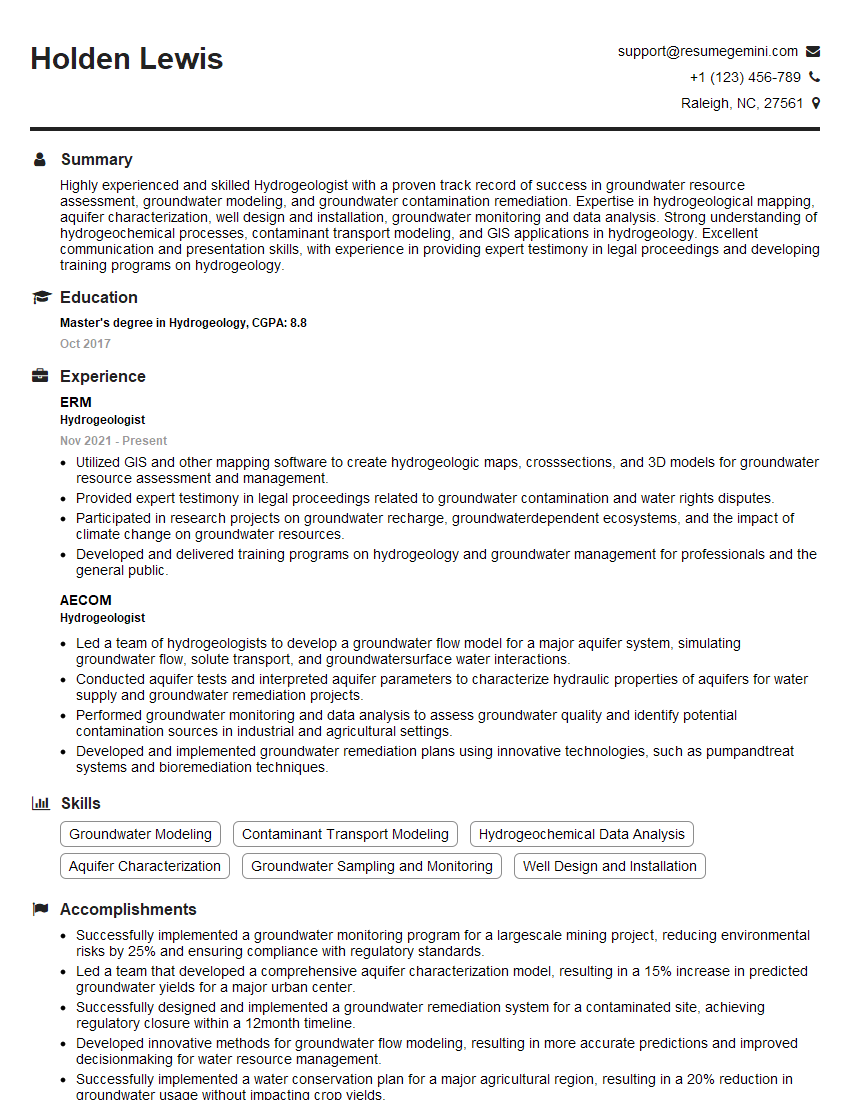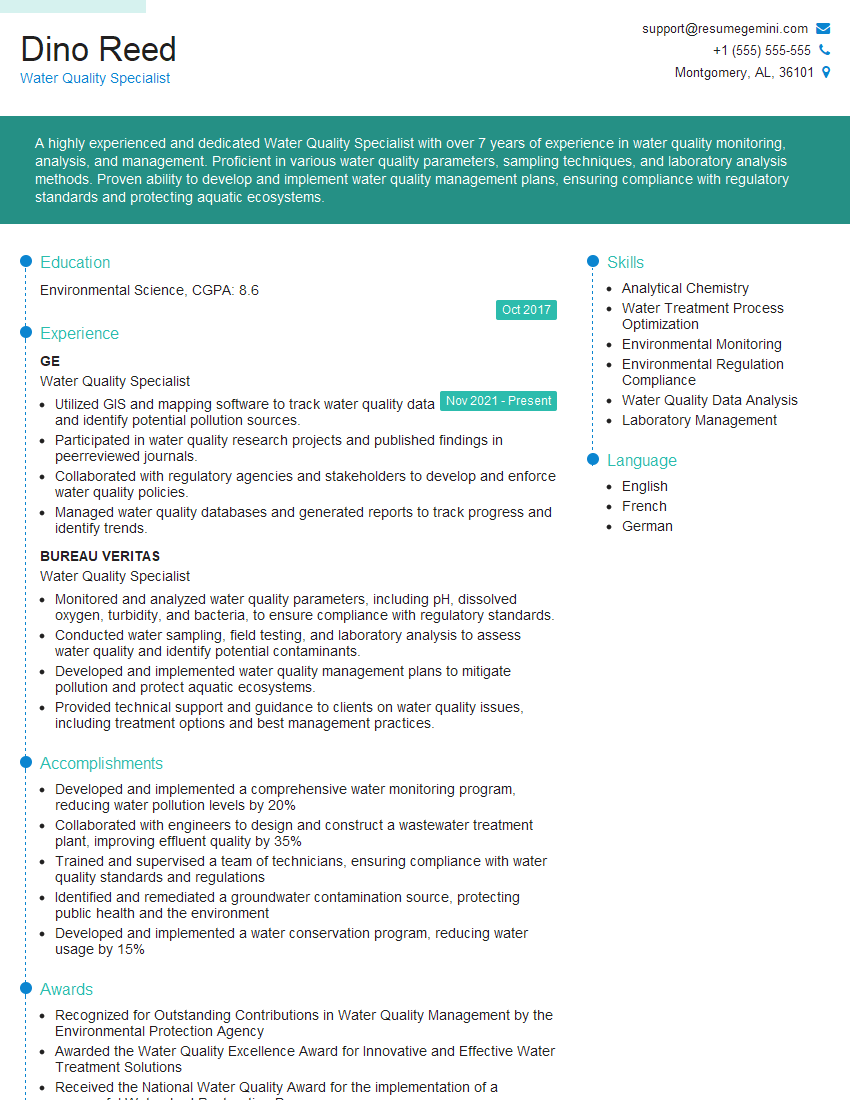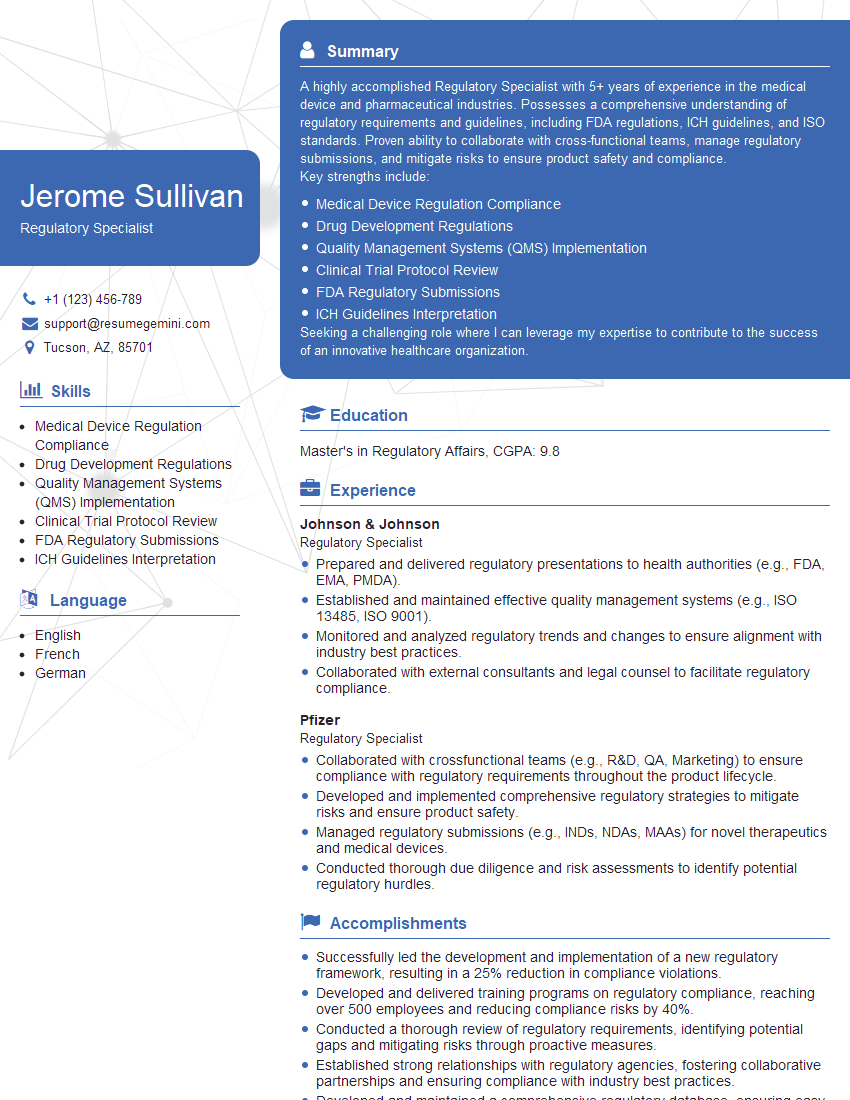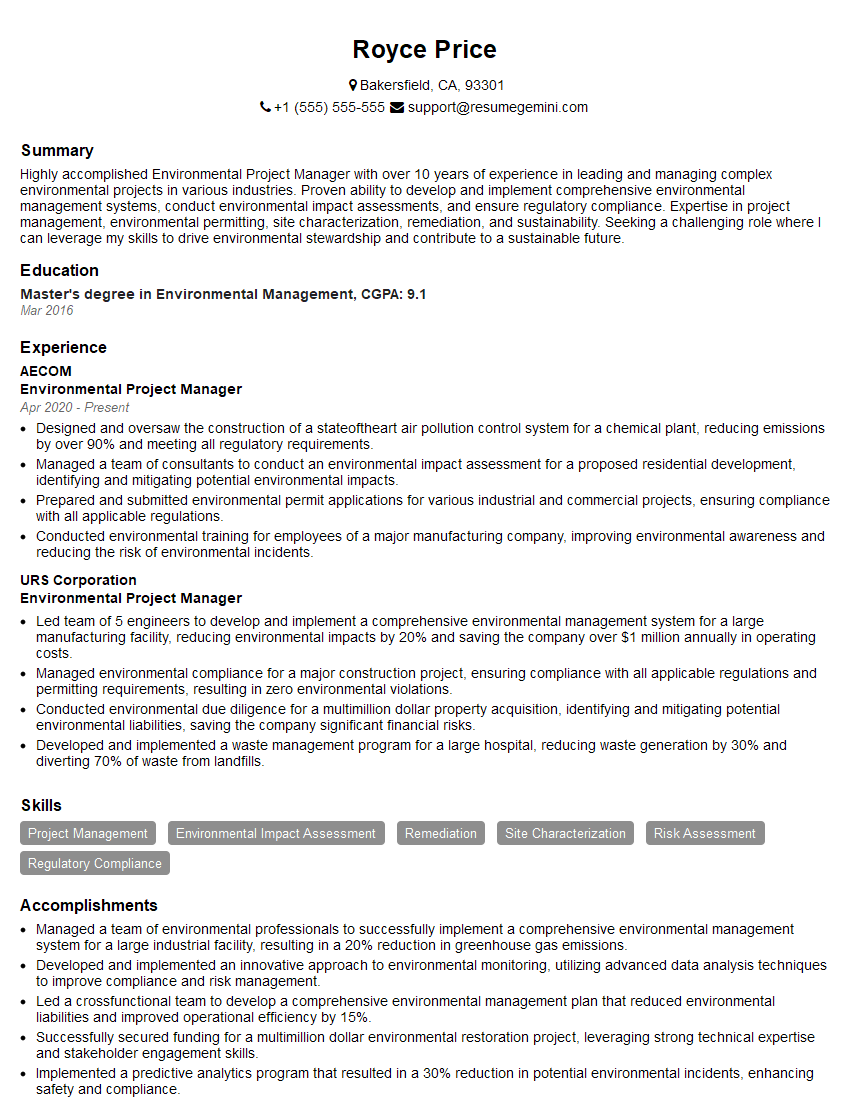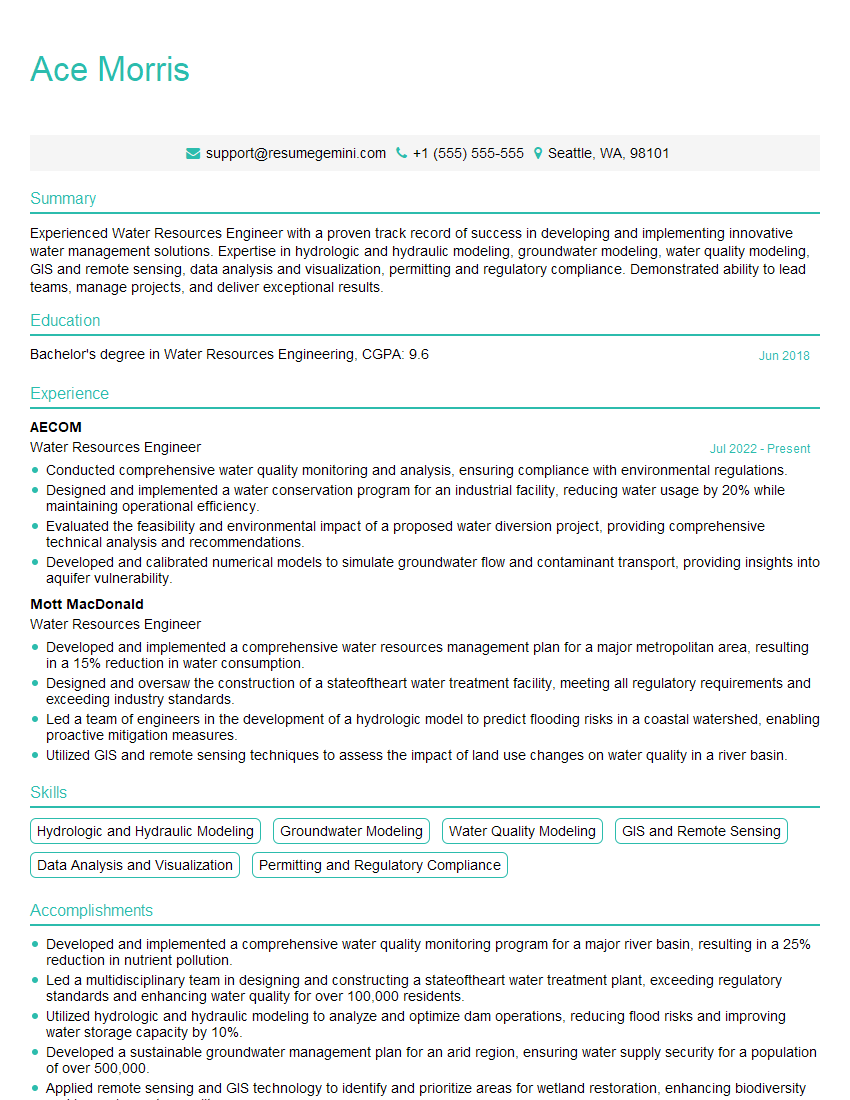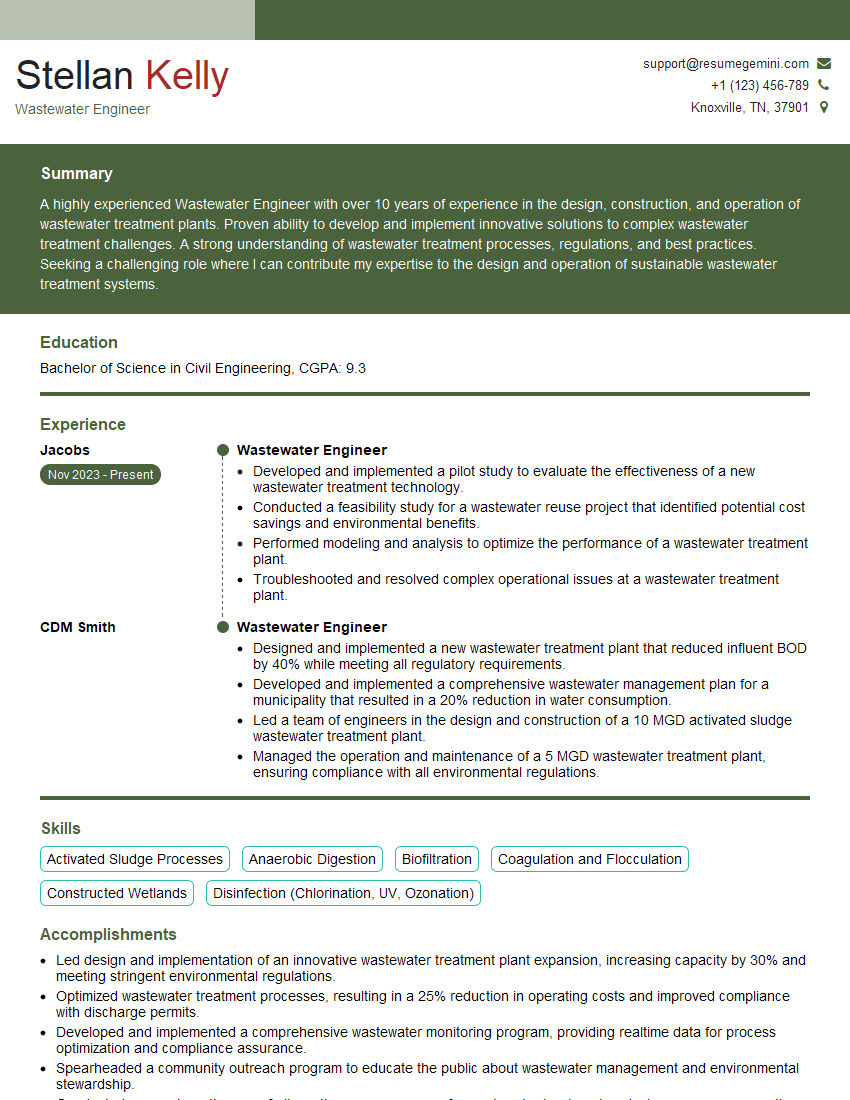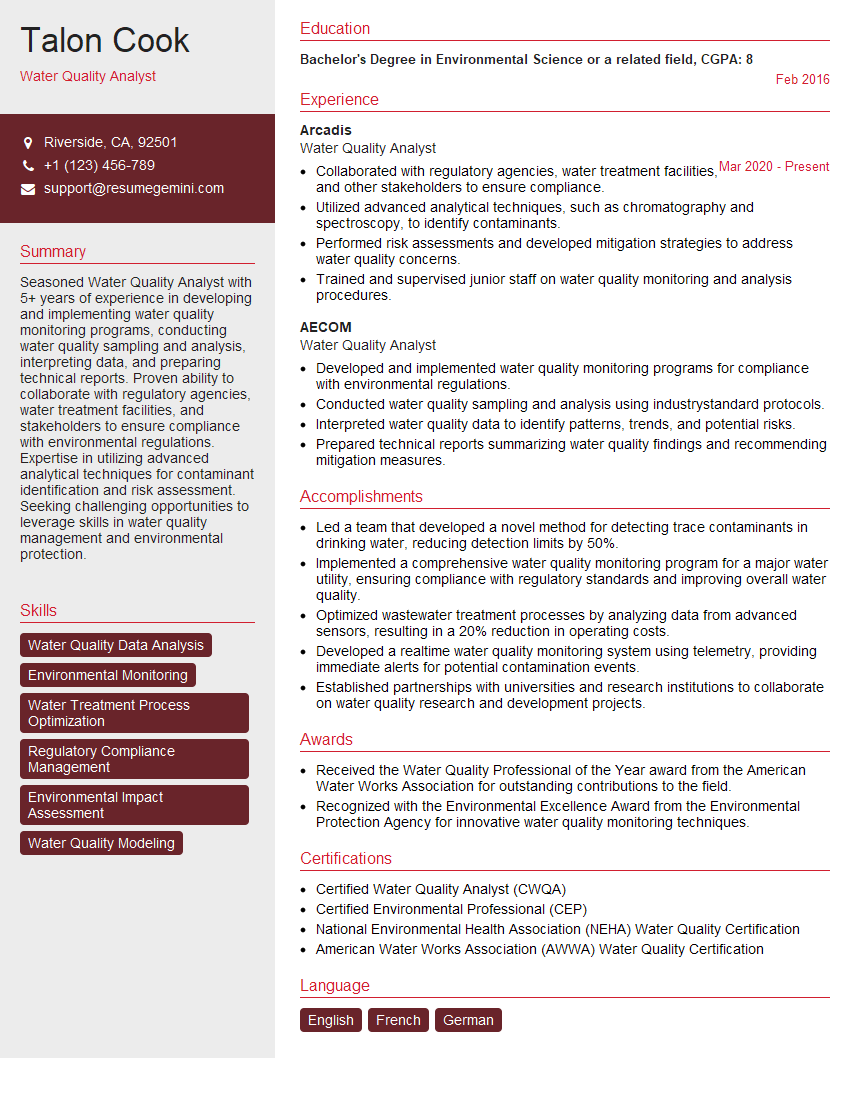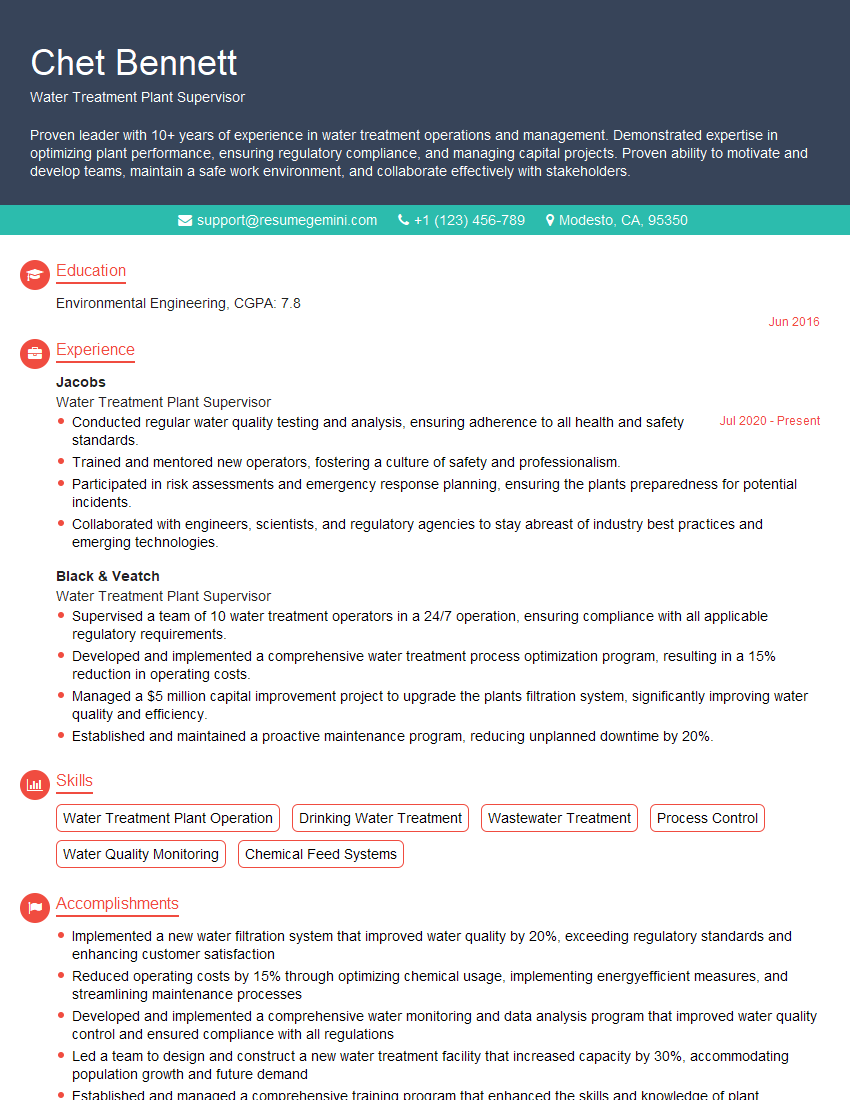Interviews are opportunities to demonstrate your expertise, and this guide is here to help you shine. Explore the essential Water and Wastewater Regulations interview questions that employers frequently ask, paired with strategies for crafting responses that set you apart from the competition.
Questions Asked in Water and Wastewater Regulations Interview
Q 1. Explain the Clean Water Act and its key provisions.
The Clean Water Act (CWA) is a cornerstone of U.S. environmental law, aiming to restore and maintain the chemical, physical, and biological integrity of the nation’s waters. Think of it as a comprehensive blueprint for water quality. Its key provisions focus on:
- Setting Water Quality Standards: States establish water quality criteria for different water bodies, based on their intended uses (e.g., drinking water, recreation, aquatic life). These standards define acceptable levels of pollutants.
- National Pollutant Discharge Elimination System (NPDES): This permit program regulates point source pollution – discharges from specific locations like pipes or ditches. It requires permits for industrial and municipal wastewater discharges, controlling the amount and type of pollutants released.
- Nonpoint Source Pollution Control: The CWA addresses nonpoint sources, which are diffuse pollution sources like agricultural runoff or urban stormwater. While permits aren’t required for these sources, the CWA promotes Best Management Practices (BMPs) to minimize pollution.
- Wetland Protection: The CWA protects wetlands, crucial ecosystems that filter pollutants and provide habitat. Unpermitted filling or destruction of wetlands is generally prohibited.
- Water Quality Monitoring and Reporting: The CWA mandates ongoing monitoring of water quality to track progress and identify pollution problems.
For example, a factory releasing wastewater into a river must obtain an NPDES permit, outlining limits on pollutants like heavy metals and organic chemicals. Failure to comply can lead to significant penalties.
Q 2. Describe the Safe Drinking Water Act and its impact on water treatment.
The Safe Drinking Water Act (SDWA) protects public health by regulating the quality of drinking water supplied by public water systems. Think of it as a guardian of our tap water. It mandates:
- Setting Maximum Contaminant Levels (MCLs): The EPA sets MCLs for various contaminants in drinking water, ensuring they are below levels that could pose health risks. These are legally enforceable limits.
- Regulation of Water Treatment: The SDWA influences the design and operation of water treatment plants, ensuring they effectively remove or reduce contaminants to meet MCLs. Technologies like filtration, disinfection, and coagulation are employed.
- Monitoring and Reporting: Public water systems must regularly monitor their water for contaminants and report the results to the EPA. This ensures ongoing quality control.
- Public Notification: In case of contamination, the SDWA mandates public notification to inform consumers and take appropriate actions.
For instance, the SDWA regulates the levels of lead and other heavy metals, requiring water treatment plants to employ strategies to minimize their presence in drinking water. This significantly protects public health, especially vulnerable populations like children.
Q 3. What are the main differences between primary, secondary, and tertiary wastewater treatment?
Wastewater treatment involves a series of processes to remove pollutants from wastewater before it’s discharged. Think of it as a multi-stage cleaning process:
- Primary Treatment: This is the initial physical process. It involves removing large debris (grit, screenings) and allowing solids to settle out (primary sedimentation). It’s like a rough cleaning, removing the largest chunks of dirt.
- Secondary Treatment: This involves biological processes to remove dissolved organic matter. Aerobic processes (using oxygen) or anaerobic processes (without oxygen) break down organic compounds. This is like a more thorough cleaning, targeting dissolved impurities.
- Tertiary Treatment: This advanced treatment goes beyond secondary, removing remaining pollutants like nutrients (nitrogen and phosphorus) and pathogens. Processes like filtration, disinfection (UV or chlorination), and advanced oxidation are used. This is like a final polish, ensuring the water is exceptionally clean.
For example, a primary treatment plant might only remove about 60% of suspended solids. A secondary treatment plant, incorporating activated sludge, can remove up to 90%. Tertiary treatment can push this even higher, producing a near-pristine effluent.
Q 4. How do you determine the appropriate treatment technology for a specific wastewater stream?
Selecting the appropriate wastewater treatment technology depends on several factors. It’s like choosing the right tool for a job:
- Wastewater Characteristics: The type and concentration of pollutants determine the needed treatment level. High levels of specific pollutants might demand advanced treatment.
- Discharge Requirements: Permit limits and receiving water quality standards dictate the effluent quality needed. Stricter regulations require more intensive treatment.
- Site Conditions: Land availability, topography, and climate influence technology selection. For example, land scarcity may favor compact treatment systems.
- Cost Considerations: Treatment costs vary greatly depending on the technology. Economic feasibility plays a key role in decision-making.
- Energy Consumption: Some technologies are more energy-intensive than others. Energy efficiency is increasingly important.
A step-by-step approach would involve: 1. Characterizing the wastewater, 2. Reviewing discharge requirements, 3. Evaluating available technologies, 4. Assessing costs and energy use, 5. Selecting the optimal technology that balances effectiveness, cost, and environmental impact.
Q 5. What are the key parameters monitored in wastewater treatment plant effluent?
Monitoring wastewater effluent is crucial to ensure compliance with discharge permits and protect receiving water bodies. Key parameters include:
- Biochemical Oxygen Demand (BOD): Measures the amount of oxygen consumed by microorganisms during the decomposition of organic matter. High BOD indicates high organic pollution.
- Chemical Oxygen Demand (COD): Measures the amount of oxygen needed to chemically oxidize organic matter. It’s a broader measure than BOD.
- Total Suspended Solids (TSS): Measures the amount of solid material suspended in the wastewater.
- Total Dissolved Solids (TDS): Measures the amount of dissolved inorganic and organic matter.
- Nutrients (Nitrogen & Phosphorus): Excessive levels can cause eutrophication (excessive algae growth) in receiving waters.
- pH: Measures acidity or alkalinity. Extreme pH levels are harmful to aquatic life.
- Pathogens (Bacteria & Viruses): Indicates potential health risks.
- Heavy Metals: Toxic substances that can accumulate in the environment and food chain.
Regular monitoring, often daily or weekly, is essential to ensure the treatment plant is operating effectively and meeting regulatory standards.
Q 6. Describe the process of obtaining a National Pollutant Discharge Elimination System (NPDES) permit.
Obtaining an NPDES permit is a crucial step for any facility discharging wastewater. It’s like getting a license to discharge. The process involves:
- Application: Submitting a detailed application to the relevant regulatory agency (usually the state), describing the facility, wastewater characteristics, and proposed treatment methods.
- Permit Review: The agency reviews the application, ensuring it meets all regulatory requirements. This may involve site visits and technical evaluations.
- Public Comment Period: Often, a public comment period allows stakeholders to review the application and provide feedback.
- Permit Issuance: If the application is approved, a permit is issued, outlining specific discharge limits and monitoring requirements.
- Compliance Monitoring: The permittee must regularly monitor effluent quality and submit reports to the agency, demonstrating compliance with permit limits.
The application process requires detailed technical information, including flow rates, pollutant concentrations, and treatment technologies. Failure to obtain or comply with an NPDES permit can result in significant fines and legal action.
Q 7. Explain the concept of Total Maximum Daily Loads (TMDLs).
Total Maximum Daily Loads (TMDLs) are calculations of the maximum amount of a pollutant that a water body can receive and still meet water quality standards. Think of it as a pollution budget. They are established when a water body is impaired (doesn’t meet water quality standards) due to pollution.
The TMDL process involves:
- Identifying Impaired Waters: Determining which water bodies don’t meet water quality standards.
- Identifying Pollutant Sources: Pinpointing the sources contributing to the impairment.
- Calculating the TMDL: Determining the maximum amount of the pollutant that the water body can receive daily and still meet water quality standards. This considers the pollutant’s load from all sources, including background levels and a margin of safety.
- Developing a Watershed Implementation Plan (WIP): Creating a plan to achieve the TMDL, specifying pollution reduction measures needed from various sources.
TMDLs are legally binding targets for pollution reduction. They guide regulatory actions and pollution control strategies to restore impaired waters to healthy conditions. For example, a TMDL for nitrogen might require reductions in fertilizer use in agricultural lands within a watershed.
Q 8. What are the common pollutants found in stormwater runoff and how are they managed?
Stormwater runoff, while seemingly benign, carries a cocktail of pollutants from various sources within a watershed. These pollutants can significantly impact water quality and aquatic ecosystems. Common culprits include:
- Sediment: Soil particles eroded from construction sites, agricultural lands, and disturbed areas. Sediment clouds the water, reducing light penetration and harming aquatic life.
- Nutrients (Nitrogen and Phosphorus): Fertilizers from lawns and farms contribute significantly to nutrient pollution, leading to eutrophication (excessive algae growth) and oxygen depletion in water bodies.
- Heavy Metals: Industrial discharges, vehicle exhaust, and wear and tear on roads can release heavy metals like lead, zinc, and copper into runoff, posing risks to human and environmental health.
- Petroleum Hydrocarbons: Oil and grease from vehicles, leaking underground storage tanks, and industrial activities contaminate runoff, harming aquatic organisms and affecting water quality.
- Bacteria and Pathogens: Pet waste, failing septic systems, and wildlife can introduce harmful bacteria and pathogens into stormwater, creating public health concerns.
Managing these pollutants requires a multi-pronged approach, including:
- Best Management Practices (BMPs): These are structural and non-structural controls designed to reduce pollution at its source. Examples include vegetated buffers, bioswales (planted drainage ditches), permeable pavements, and stormwater detention basins.
- Public Education and Outreach: Educating citizens about responsible pet waste disposal, proper fertilization techniques, and car maintenance helps minimize pollution at its source.
- Regulations and Enforcement: Stricter regulations and enforcement measures are crucial to ensure compliance with stormwater management standards and hold polluters accountable.
- Green Infrastructure: Utilizing natural systems like wetlands and forested areas to treat stormwater runoff can significantly improve water quality.
For example, a city might implement a low-impact development (LID) strategy, incorporating green infrastructure into new development projects to manage stormwater runoff more effectively.
Q 9. Describe different methods for disinfecting drinking water.
Disinfecting drinking water is crucial to eliminate harmful pathogens like bacteria, viruses, and protozoa. Several methods are employed, each with its pros and cons:
- Chlorination: This is the most common method, involving the addition of chlorine to kill pathogens. Chlorine is effective, relatively inexpensive, and provides residual disinfection in the distribution system. However, it can react with organic matter to form disinfection byproducts (DBPs), some of which are potentially harmful.
- Chloramination: This involves combining chlorine with ammonia to create chloramines, a longer-lasting disinfectant. Chloramines produce fewer DBPs than free chlorine, but they can be less effective against certain pathogens and corrode pipes more readily.
- Ozone Treatment: Ozone is a powerful disinfectant that quickly kills pathogens without leaving significant residuals. It’s effective against a broad range of pathogens and doesn’t produce DBPs in the same way as chlorine. However, ozone is more expensive than chlorine and requires specialized equipment.
- Ultraviolet (UV) Disinfection: UV light damages the DNA of pathogens, rendering them inactive. UV disinfection is effective, doesn’t produce DBPs, and requires minimal chemical usage. However, it doesn’t provide residual disinfection and may be less effective against some resistant organisms.
Often, a combination of methods, such as pre-oxidation with ozone followed by chlorination, is used to maximize disinfection efficacy and minimize the formation of undesirable byproducts. The selection of a specific method depends on factors like water quality, cost, available infrastructure, and regulatory requirements.
Q 10. What are the regulations surrounding the disposal of wastewater sludge?
Wastewater sludge, the semi-solid material left after wastewater treatment, contains concentrated pollutants and needs careful management. Regulations surrounding its disposal are stringent and vary by jurisdiction, but generally focus on minimizing environmental and human health risks. Key aspects include:
- Dewatering and Stabilization: Before disposal, sludge must be dewatered to reduce its volume and weight, often through processes like centrifugation or belt presses. Stabilization, usually through anaerobic digestion, reduces pathogens and odors.
- Disposal Options: Common options include land application (as fertilizer, after stringent testing), landfilling (in specialized landfills designed for hazardous waste), incineration (with careful air pollution control), and beneficial reuse (e.g., in construction materials).
- Regulatory Compliance: Disposal must comply with regulations set by local, regional, and national environmental agencies. These regulations specify limits on pollutants like heavy metals, pathogens, and organic matter in the sludge and may require permits for disposal operations.
- Monitoring and Reporting: Regular monitoring of sludge quality and disposal operations is essential to ensure compliance with regulations and protect the environment. Detailed records must be kept and reported to regulatory agencies.
For instance, a wastewater treatment plant might choose anaerobic digestion to stabilize sludge, reducing its volume and generating biogas, which can be used for energy generation. Then, the dewatered sludge might be applied to agricultural lands, provided it meets stringent quality criteria to avoid heavy metal contamination of the soil or groundwater.
Q 11. Explain the importance of water quality monitoring and sampling.
Water quality monitoring and sampling are essential for protecting public health and the environment. They provide data to assess the overall health of water bodies, identify pollution sources, evaluate the effectiveness of treatment processes, and ensure compliance with regulatory standards. Think of it as a vital checkup for our water resources.
Monitoring involves regularly collecting water samples and analyzing them for various parameters, including:
- Physical parameters: Temperature, turbidity (cloudiness), color, odor.
- Chemical parameters: pH, dissolved oxygen, nutrients (nitrogen and phosphorus), heavy metals, pesticides, organic matter.
- Biological parameters: Bacteria, viruses, algae, zooplankton.
Sampling strategies must consider factors like location, frequency, and depth to provide representative data. For example, a river might be sampled at multiple locations along its length to identify pollution sources, or a well might be sampled regularly to monitor groundwater quality. The frequency of sampling depends on factors like the intended use of water and the risk of pollution.
Accurate and timely data from water quality monitoring programs enables informed decision-making for water resource management, pollution control, and public health protection. Imagine having to treat illnesses from contaminated water without knowing the source – that’s the importance of water quality monitoring.
Q 12. How do you interpret water quality data and identify potential problems?
Interpreting water quality data involves comparing measured values against established standards and guidelines. This requires a strong understanding of water chemistry, microbiology, and statistical analysis. Here’s a breakdown of the process:
- Data Validation: First, check for errors and outliers in the data. Are there any inconsistencies that need clarification? Was the sampling and analysis conducted correctly?
- Comparison with Standards: Compare measured values with established water quality standards (e.g., drinking water standards, recreational water quality standards, effluent discharge limits). Are any parameters exceeding the allowed limits?
- Trend Analysis: Analyze data trends over time. Are there any patterns or changes that indicate a potential problem? Is a pollutant concentration increasing over time?
- Spatial Analysis: If data are from multiple locations, analyze spatial patterns to identify potential pollution sources or areas of concern. Are there elevated contaminant levels in a specific region?
- Statistical Analysis: Use statistical methods to identify significant differences between data sets or to quantify uncertainty in measurements.
For example, if dissolved oxygen levels in a lake consistently fall below a critical threshold, indicating potential hypoxia (low oxygen), this suggests a problem such as eutrophication. Further investigation might involve analyzing nutrient levels and identifying sources of nutrient pollution, like agricultural runoff.
Interpreting data is not merely about identifying violations; it’s about understanding the underlying causes and recommending appropriate corrective actions. This could involve investigating industrial discharges, developing better agricultural practices, or implementing stricter regulations.
Q 13. What are the key considerations for designing a wastewater treatment plant?
Designing a wastewater treatment plant requires careful consideration of several factors to ensure efficient and effective treatment while adhering to environmental regulations and minimizing costs. Key considerations include:
- Wastewater characteristics: The type and quantity of wastewater significantly influence treatment requirements. Industrial wastewater, for example, often needs specialized treatment to remove specific pollutants.
- Site selection: The location of the plant must be accessible, have adequate space, and minimize environmental impact. Proximity to water bodies for effluent discharge needs careful consideration.
- Treatment processes: Selecting appropriate treatment technologies depends on the required effluent quality and the characteristics of the wastewater. This involves choosing from a range of primary, secondary, and tertiary treatment options.
- Capacity and future expansion: The plant’s design must accommodate current and projected wastewater flow, allowing for future expansion without significant disruption.
- Energy efficiency: Designing for energy efficiency reduces operational costs and minimizes the environmental footprint of the plant. Technologies like anaerobic digestion can generate biogas, which can be used for energy production.
- Sludge management: A robust sludge management plan is crucial, encompassing dewatering, stabilization, and disposal or beneficial reuse methods.
- Regulatory compliance: The design must comply with all applicable local, regional, and national environmental regulations, including effluent discharge limits.
- Cost-effectiveness: Balancing treatment effectiveness with construction and operating costs is paramount. Life-cycle costing analysis helps in making informed decisions.
For example, a plant serving a rapidly growing community might need a modular design, allowing for easier expansion as the population increases. A plant located near sensitive ecosystems might require advanced treatment technologies to ensure minimal environmental impact.
Q 14. Describe the different types of wastewater treatment systems.
Wastewater treatment systems employ a series of processes to remove pollutants from wastewater. Different systems exist, ranging from simple to complex, depending on the required effluent quality and the available resources:
- Septic Systems: These are on-site systems commonly used in rural areas. They involve a septic tank for primary treatment (settling of solids) and a leach field for secondary treatment (filtration and microbial degradation).
- Conventional Treatment Plants: These plants employ a series of processes including:
- Primary Treatment: Physical processes like screening, grit removal, and sedimentation to remove large solids and settleable particles.
- Secondary Treatment: Biological processes, such as activated sludge or trickling filters, use microorganisms to degrade organic matter.
- Tertiary Treatment: Advanced processes, such as filtration, disinfection, and nutrient removal, further improve effluent quality to meet stringent discharge standards.
- Advanced Treatment Systems: These plants utilize more sophisticated technologies to remove specific pollutants, such as membrane bioreactors for enhanced biological treatment and advanced oxidation processes for removing recalcitrant chemicals.
- Constructed Wetlands: These natural systems use plants and microorganisms to treat wastewater. They are cost-effective and aesthetically pleasing but may require larger land areas.
The choice of system depends on various factors such as the size of the community, the nature of the wastewater, environmental regulations, and available land and financial resources. For instance, a small rural community might opt for a constructed wetland, while a large city might require a large conventional treatment plant with advanced treatment capabilities.
Q 15. Explain the role of biological processes in wastewater treatment.
Biological processes are the heart of modern wastewater treatment, harnessing the power of naturally occurring microorganisms to break down organic pollutants. Think of it like a miniature, highly controlled ecosystem within a treatment plant. These processes primarily focus on removing organic matter, nitrogen, and phosphorus from wastewater.
Activated Sludge Process: This is the most common method. Wastewater is mixed with activated sludge (a mixture of microorganisms) in an aeration tank. Oxygen is introduced, allowing the microbes to consume organic matter. The resulting sludge is then separated, treated further, and either recycled or disposed of.
Trickling Filters: Wastewater is trickled over a bed of media (like rocks or plastic) coated with a biofilm of microorganisms. As the water flows, the biofilm breaks down the organic matter. This method is often simpler and less energy-intensive than activated sludge.
Anaerobic Digestion: This process utilizes bacteria that thrive in the absence of oxygen to break down organic matter, producing biogas (a mixture of methane and carbon dioxide) as a byproduct. This biogas can be used for energy generation.
These biological processes are crucial because they significantly reduce the polluting load of wastewater, making it safe for discharge or reuse, protecting our environment and public health.
Career Expert Tips:
- Ace those interviews! Prepare effectively by reviewing the Top 50 Most Common Interview Questions on ResumeGemini.
- Navigate your job search with confidence! Explore a wide range of Career Tips on ResumeGemini. Learn about common challenges and recommendations to overcome them.
- Craft the perfect resume! Master the Art of Resume Writing with ResumeGemini’s guide. Showcase your unique qualifications and achievements effectively.
- Don’t miss out on holiday savings! Build your dream resume with ResumeGemini’s ATS optimized templates.
Q 16. What are the challenges associated with managing combined sewer overflows (CSOs)?
Combined sewer overflows (CSOs) present a significant challenge to water quality management. CSOs occur when a combined sewer system – one that carries both stormwater and wastewater – becomes overloaded during heavy rainfall. This results in untreated or partially treated sewage being discharged directly into receiving water bodies like rivers or lakes.
High Pollutant Loads: CSOs release large amounts of pollutants, including bacteria, viruses, nutrients (nitrogen and phosphorus), and heavy metals, causing severe water quality degradation and harming aquatic life.
Costly Remediation: Addressing CSO issues requires substantial investment in infrastructure upgrades, such as constructing storage tanks, implementing green infrastructure solutions (like rain gardens), and separating stormwater and wastewater systems. These projects are often expensive and complex.
Regulatory Compliance: Meeting stringent environmental regulations related to CSOs can be difficult, leading to potential fines and legal action.
Public Health Risks: The discharge of untreated sewage poses a significant risk to public health, potentially leading to waterborne illnesses.
Managing CSOs requires a comprehensive approach involving long-term planning, technological innovation, and effective regulatory frameworks. For example, cities are increasingly incorporating green infrastructure into their urban design to manage stormwater runoff and reduce the burden on combined sewer systems.
Q 17. How do you address violations of water quality regulations?
Addressing water quality violations requires a systematic and proactive approach. The first step is always to identify the cause of the violation through thorough investigation. This might involve reviewing operational data, inspecting facilities, and collecting water samples for analysis.
Investigation and Root Cause Analysis: Determine why the violation occurred. Was it due to equipment malfunction, operator error, or inadequate maintenance?
Corrective Actions: Implement immediate measures to stop the violation and prevent its recurrence. This could involve repairing equipment, improving operational procedures, or upgrading facilities.
Reporting and Documentation: Meticulously document all aspects of the violation, including the cause, corrective actions taken, and preventative measures implemented. This documentation is essential for regulatory compliance.
Regulatory Reporting: Promptly report the violation to the appropriate regulatory agency, providing detailed information about the event and the corrective actions taken. This is crucial for maintaining a good relationship with regulatory bodies.
Preventative Measures: Develop and implement a comprehensive preventative maintenance program to minimize the risk of future violations. This could include regular inspections, equipment upgrades, and employee training.
Failure to adequately address violations can lead to significant penalties, including fines, legal action, and damage to reputation. Proactive and transparent communication with regulatory agencies is key to successful remediation.
Q 18. What are the best management practices for reducing nutrient pollution in water bodies?
Nutrient pollution, primarily from excessive nitrogen and phosphorus, fuels harmful algal blooms, depletes oxygen in water bodies (causing dead zones), and degrades overall water quality. Best management practices (BMPs) focus on reducing nutrient runoff from various sources.
Agricultural BMPs: These include practices like using nutrient management plans (tailored fertilizer applications), cover cropping (planting crops to protect soil), and buffer strips (vegetated areas along water bodies to filter runoff).
Urban BMPs: These involve strategies such as stormwater retention ponds, rain gardens, permeable pavements, and green roofs to capture and treat stormwater runoff before it reaches water bodies.
Wastewater Treatment Upgrades: Improving wastewater treatment plants to enhance nutrient removal (through advanced treatment processes) significantly reduces nutrient discharge.
Septic System Maintenance: Regular inspection and maintenance of septic systems are crucial for preventing nutrient leakage into groundwater.
Public Education and Awareness: Educating the public about responsible fertilizer use, proper waste disposal, and the importance of protecting water quality plays a vital role in reducing nutrient pollution.
Implementing a combination of these BMPs, tailored to the specific watershed characteristics and sources of pollution, is critical for effectively reducing nutrient pollution and restoring water quality.
Q 19. Explain the concept of water conservation and its importance.
Water conservation involves the responsible use and management of water resources to ensure their sustainable availability for present and future generations. It’s about using water wisely and efficiently, minimizing waste, and protecting water quality.
The importance of water conservation cannot be overstated:
Environmental Protection: Conserving water helps protect aquatic ecosystems, maintains biodiversity, and reduces the strain on water resources.
Economic Benefits: Reduced water consumption lowers water bills, minimizes the need for expensive water infrastructure projects, and conserves energy used for water treatment and distribution.
Social Equity: Ensuring access to clean and safe water for all requires responsible management and conservation.
Climate Change Resilience: Water conservation is critical for mitigating the impacts of climate change, which includes increased drought frequency and intensity.
Water conservation involves individual actions (like shorter showers, fixing leaks, and using water-efficient appliances) and broader policies (like water pricing and regulations). Implementing both is essential for achieving sustainable water management.
Q 20. What are the different types of water meters and their applications?
Water meters are essential tools for measuring water consumption. Different types exist, each with specific applications:
Positive Displacement Meters: These meters measure water flow by trapping a precise volume of water and counting the number of times this volume passes through the meter. They are highly accurate, especially for low flow rates, and are commonly used for residential and small commercial applications.
Velocity Meters: These meters measure the speed of water flowing through a pipe. They are typically used for larger pipes and higher flow rates, such as in industrial settings or large water distribution systems.
Turbine Meters: These meters use a turbine to measure the flow rate. The rotation speed of the turbine is proportional to the flow rate. They are accurate and reliable but may be less suitable for very low flow rates.
Electromagnetic Meters: These meters use Faraday’s law of induction to measure flow. They are highly accurate and suitable for a wide range of flow rates and fluid types, often used in industrial settings.
Smart Meters: These are advanced meters that incorporate communication technology to transmit data remotely. They provide real-time consumption information, enabling better water management and leak detection. They’re increasingly used in both residential and commercial settings.
The choice of water meter depends on factors such as flow rate, accuracy requirements, cost, and the need for remote monitoring capabilities.
Q 21. Describe different methods for controlling corrosion in water distribution systems.
Corrosion in water distribution systems can lead to pipe failure, water quality degradation, and increased maintenance costs. Several methods exist to control corrosion:
Corrosion Inhibitors: These chemicals are added to the water to form a protective layer on the pipe surfaces, preventing corrosion. Examples include orthophosphates and zinc orthophosphates.
Cathodic Protection: This electrochemical method uses sacrificial anodes or impressed current to protect metal pipes from corrosion. It’s particularly effective for underground pipes.
Internal Liners: Applying a protective lining inside pipes creates a barrier between the water and the pipe material, preventing corrosion. Materials such as cement mortar and epoxy resins are commonly used.
Pipe Material Selection: Choosing corrosion-resistant materials like ductile iron, PVC, or high-density polyethylene can significantly reduce corrosion problems.
Water Quality Control: Maintaining appropriate water pH, alkalinity, and dissolved oxygen levels can help minimize corrosion. Regular monitoring and adjustments are crucial.
The best method for controlling corrosion depends on several factors, including the type of pipe material, water quality, and cost considerations. Often, a combination of methods is employed for optimal protection.
Q 22. What are the health risks associated with contaminated water?
Contaminated water poses significant health risks, ranging from mild discomfort to life-threatening illnesses. The dangers depend on the type and concentration of contaminants present.
- Waterborne diseases: Bacteria (like E. coli and Salmonella), viruses (like norovirus and rotavirus), and parasites (like Giardia and Cryptosporidium) can cause diarrhea, vomiting, fever, and dehydration. In severe cases, these can lead to death, especially in young children and the elderly.
- Chemical contamination: Exposure to heavy metals (lead, mercury, arsenic), pesticides, and industrial chemicals can cause various health problems, including neurological damage, cancer, and reproductive issues. For example, lead poisoning can severely impair cognitive development in children.
- Microbial contamination: Harmful algae blooms can produce toxins that cause skin irritation, respiratory problems, and liver damage. Similarly, certain bacteria can cause skin infections or other serious diseases.
Think of it like this: clean water is like a healthy foundation for your body; contaminated water introduces harmful elements that disrupt this foundation, leading to various health complications depending on the severity and type of contamination.
Q 23. Explain the role of GIS in managing water and wastewater infrastructure.
Geographic Information Systems (GIS) are incredibly valuable in managing water and wastewater infrastructure. They provide a visual platform to manage, analyze, and understand complex spatial data.
- Asset Management: GIS allows for the mapping and tracking of all assets, including pipes, pumps, treatment plants, and storage tanks. This enables efficient maintenance scheduling, leak detection, and planning for future upgrades.
- Network Analysis: GIS helps model water flow within the network, identifying areas prone to pressure problems or potential failures. This helps optimize water distribution and minimize water loss.
- Emergency Response: During emergencies like pipe bursts or contamination incidents, GIS facilitates rapid identification of affected areas, enabling efficient resource allocation and communication.
- Public Engagement: GIS-based maps can communicate information about water quality, service areas, and infrastructure projects to the public, enhancing transparency and engagement.
For example, a utility company might use GIS to identify sections of aging pipes with high failure rates, allowing them to prioritize maintenance efforts and reduce the risk of water main breaks.
Q 24. How do you ensure compliance with water and wastewater regulations?
Ensuring compliance with water and wastewater regulations is a multi-faceted process involving rigorous monitoring, record-keeping, and proactive management.
- Regular Monitoring: This includes consistent sampling and testing of water sources and treated effluent to ensure compliance with parameters like pH, turbidity, and levels of various contaminants. The frequency and specific tests depend on the applicable regulations and the type of water system.
- Record Keeping: Detailed and accurate records of all sampling events, test results, maintenance activities, and corrective actions must be maintained. This documentation is crucial for audits and demonstrating compliance.
- Compliance Programs: Proactive compliance programs are essential. This involves regular internal audits, staff training on regulations, and implementation of preventative measures to minimize the risk of non-compliance.
- Reporting: Regular reports to regulatory agencies are necessary, providing updates on water quality, operational performance, and compliance status.
Imagine it like a doctor regularly checking a patient’s vital signs – consistent monitoring and documentation are crucial for identifying problems early and preventing serious issues.
Q 25. What are the current trends in water and wastewater management?
The water and wastewater management field is constantly evolving. Several key trends are shaping the future:
- Smart Water Management: Increased use of sensors, IoT devices, and advanced analytics to optimize water use, improve infrastructure management, and enhance real-time monitoring.
- Water Reuse and Recycling: Growing emphasis on reclaiming and reusing treated wastewater for non-potable purposes like irrigation and industrial processes, to conserve freshwater resources.
- Climate Change Adaptation: Addressing the impacts of climate change, such as increased drought frequency and intensity, through strategies like improved water conservation and infrastructure resilience.
- Sustainable Practices: Integration of environmentally friendly technologies and practices, reducing energy consumption and minimizing environmental footprints.
- Data Analytics and AI: Leveraging advanced analytics and AI to predict future demands, optimize water distribution, and identify potential problems early on.
For example, many cities are now investing in smart water meters that provide real-time data on water consumption, allowing them to detect leaks quickly and improve water conservation efforts.
Q 26. Describe your experience with water quality modeling and simulation.
I have extensive experience with water quality modeling and simulation, using both hydrodynamic and water quality models. This includes using software like MIKE 11, QUAL2K, and SWMM.
My experience spans a wide range of applications, including:
- River water quality assessment: Simulating pollutant transport and fate to determine the impact of different pollution sources.
- Reservoir management: Modeling water levels, temperature, and water quality parameters to optimize reservoir operations.
- Wastewater treatment plant design and optimization: Evaluating the performance of treatment processes and identifying opportunities for improvement.
- Coastal water quality modeling: Assessing the impact of wastewater discharges on coastal ecosystems.
In one project, I used MIKE 11 to simulate the impact of a proposed industrial discharge on a river system. The model helped determine the necessary treatment level to meet water quality standards and avoid environmental damage. This demonstrated the crucial role modeling plays in informed decision-making.
Q 27. What software and tools are you proficient in for water and wastewater analysis?
I am proficient in several software and tools used for water and wastewater analysis, including:
- Water quality modeling software: MIKE 11, QUAL2K, SWMM, HEC-RAS
- GIS software: ArcGIS, QGIS
- Statistical software: R, SPSS
- Data management software: Excel, Access
- Laboratory equipment and instruments: I’m familiar with a wide array of lab instruments used for water quality testing, from basic pH meters to sophisticated chromatography systems.
My expertise extends beyond simply using these tools; I understand the underlying principles and can effectively interpret the results to make informed recommendations.
Q 28. Explain your understanding of water rights and allocation.
Water rights and allocation are complex legal and regulatory frameworks that govern the ownership and use of water resources. These frameworks vary significantly depending on location and jurisdiction.
Key aspects of my understanding include:
- Types of Water Rights: These can include riparian rights (associated with land ownership bordering a water body), appropriative rights (based on prior use and beneficial application), and other types specific to certain regions.
- Water Allocation: This involves dividing water resources among various users (e.g., agriculture, industry, municipalities) based on established water rights and availability. This often requires careful balancing of competing needs.
- Water Management Institutions: Various agencies and organizations at local, regional, and national levels are responsible for administering water rights and ensuring equitable allocation. Understanding their roles is crucial.
- Legal Considerations: Water rights are often subject to legal challenges and disputes. I understand the legal precedents and processes involved in resolving such conflicts.
For example, in many arid regions, appropriative rights are prevalent. This means that those who first put water to beneficial use generally have senior rights, potentially leading to complex allocation challenges during droughts.
Key Topics to Learn for Water and Wastewater Regulations Interview
- Safe Drinking Water Act (SDWA) Compliance: Understand the key provisions, monitoring requirements, and potential violations related to the SDWA. Consider practical applications like interpreting water quality reports and identifying potential non-compliance issues.
- Clean Water Act (CWA) Compliance: Focus on effluent limitations, discharge permits (NPDES), and best management practices (BMPs) for wastewater treatment. Explore case studies demonstrating successful implementation of CWA regulations.
- Water Treatment Processes: Master the theoretical understanding of various treatment processes (coagulation, flocculation, filtration, disinfection) and their practical application in ensuring safe drinking water. Analyze scenarios involving process optimization and troubleshooting.
- Wastewater Treatment Processes: Gain a thorough grasp of primary, secondary, and tertiary treatment methods. Be prepared to discuss practical applications like sludge management, biosolids handling, and the impact of different treatment technologies on effluent quality.
- Permitting and Regulatory Compliance: Understand the process of obtaining and maintaining permits, reporting requirements, and the consequences of non-compliance. Explore scenarios involving permit applications, inspections, and enforcement actions.
- Water Quality Monitoring and Analysis: Familiarize yourself with common water quality parameters, laboratory testing methods, and data interpretation. Practice analyzing data to identify trends and potential problems.
- Environmental Impact Assessment: Learn how to assess the environmental impact of water and wastewater projects. This includes understanding relevant legislation and methodologies for evaluating potential risks and mitigations.
- Emerging Contaminants and Treatment Technologies: Understand the challenges posed by emerging contaminants (e.g., pharmaceuticals, microplastics) and innovative treatment technologies designed to address them. Discuss the implications for regulatory frameworks.
Next Steps
Mastering Water and Wastewater Regulations is crucial for career advancement in this vital field. A strong understanding of these regulations demonstrates your commitment to environmental protection and public health, opening doors to leadership roles and specialized positions. To significantly increase your job prospects, create an ATS-friendly resume that highlights your skills and experience effectively. ResumeGemini is a trusted resource to help you build a professional and impactful resume. We provide examples of resumes tailored to the Water and Wastewater Regulations field to guide you in creating a document that showcases your qualifications effectively.
Explore more articles
Users Rating of Our Blogs
Share Your Experience
We value your feedback! Please rate our content and share your thoughts (optional).
What Readers Say About Our Blog
Hi, I have something for you and recorded a quick Loom video to show the kind of value I can bring to you.
Even if we don’t work together, I’m confident you’ll take away something valuable and learn a few new ideas.
Here’s the link: https://bit.ly/loom-video-daniel
Would love your thoughts after watching!
– Daniel
This was kind of a unique content I found around the specialized skills. Very helpful questions and good detailed answers.
Very Helpful blog, thank you Interviewgemini team.
